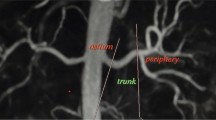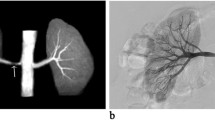Abstract
Objectives
To evaluate steady-state free precession (SSFP) non-contrast-enhanced MR angiography (Unenhanced-MRA) versus conventional contrast-enhanced MR angiography (CE-MRA) in the detection of renal artery stenosis (RAS).
Methods
Retrospective analysis of 70 consecutive patients referred for suspected RAS, examined by SSFP Unenhanced-MRA and CE-MRA. Image quality, quality of visible renal arterial segments, presence and grade of RAS were evaluated. The Unenhanced-MRA were compared against reference standard CE-MRA results.
Results
149 renal arteries were assessed with 21 haemodynamically significant stenoses (≥50% stenosis) demonstrated by CE-MRA. Combined sensitivity and specificity for RAS detection by Unenhanced-MRA was 72.8% and 97.8% respectively. There is substantial correlation for RAS detection between Unenhanced-MRA and CE-MRA with kappa values of between 0.64 and 0.74. There was excellent inter-observer correlation for RAS on Unenhanced-MRA (kappa values 0.82–1.0).
Conclusions
Our study has shown Unenhanced-MRA to be a viable alternative to CE-MRA, yielding images equal in quality without the requirement for gadolinium contrast agents. The sensitivity and specificity for the detection of haemodynamically significant stenoses are comparable to CE-MRA. Potentially, Unenhanced-MRA could be used as an initial investigation to avoid performing CE-MRA in patients with normal renal arteries, however we suggest that its real value will lie in being complementary to CE-MRA.




Similar content being viewed by others
References
Prince MR, Narasimham DL, Stanley JC, Chenevert TL, Williams DM, Marx MV, Cho KJ (1995) Breath-hold gadolinium-enhanced MR angiography of the abdominal aorta and its major branches. Radiology 197:785–792
Hany TF, Debatin JF, Leung DA, Pfammatter T (1997) Evaluation of the aortoiliac and renal arteries: comparison of breath-hold, contrast-enhanced, three-dimensional MR angiography with conventional catheter angiography. Radiology 204:357–362
De Cobelli F, Venturini M, Vanzulli A, Sironi S, Salvioni M, Angeli E, Scifo P, Garancini MP, Quartagno R et al (2000) Renal arterial stenosis: prospective comparison of color Doppler US and breath-hold, three-dimensional, dynamic, gadolinium-enhanced MR angiography. Radiology 214:373–380
Fain SB, King BF, Breen JF, Kruger DG, Riederer SJ (2001) High-spatial-resolution contrast-enhanced MR angiography of the renal arteries: a prospective comparison with digital subtraction angiography. Radiology 218:481–490
Schoenberg SO, Rieger J, Weber CH, Michaely HJ, Waggershauser T, Ittrich C, Dietrich O, Reiser MF (2005) High-spatial-resolution MR angiography of renal arteries with integrated parallel acquisitions: comparison with digital subtraction angiography and US. Radiology 235:687–698
Jahnke C, Paetsch I, Achenbach S, Schnackenburg B, Gebker R, Fleck E, Nagel E (2006) Coronary MR imaging: breath-hold capability and patterns, coronary artery rest periods, and beta-blocker use. Radiology 239:71–78
Kaandorp DW, Vasbinder GB, de Haan MW, Kemerink GJ, van Engelshoven JM (2000) Motion of the proximal renal artery during the cardiac cycle. J Magn Reson Imaging 12:924–928
Cowper SE, Robin HS, Steinberg SM, Su LD, Gupta S, LeBoit PE (2000) Scleromyxoedema-like cutaneous diseases in renal-dialysis patients. Lancet 356:1000–1001
Broome DR (2008) Nephrogenic systemic fibrosis associated with gadolinium based contrast agents: a summary of the medical literature reporting. Eur J Radiol 66:230–234
Weinreb JC, Kuo PH (2009) Nephrogenic systemic fibrosis. Magn Reson Imaging Clin N Am 17:159–167
Herborn CU, Watkins DM, Runge VM, Gendron JM, Montgomery ML, Naul LG (2006) Renal arteries: comparison of steady-state free precession MR angiography and contrast-enhanced MR angiography. Radiology 239:263–268
Glockner JF, Takahashi N, Kawashima A, Woodrum DA, Stanley DW, Takei N, Miyoshi M, Sun W (2010) Non-contrast renal artery MRA using an inflow inversion recovery steady state free precession technique (Inhance): comparison with 3D contrast-enhanced MRA. J Magn Reson Imaging 31:1411–1418
Wyttenbach R, Braghetti A, Wyss M, Alerci M, Briner L, Santini P, Cozzi L, Di Valentino M, Katoh M et al (2007) Renal artery assessment with nonenhanced steady-state free precession versus contrast-enhanced MR angiography. Radiology 245:186–195
Maki JH, Wilson GJ, Eubank WB, Glickerman DJ, Millan JA, Hoogeveen RM (2007) Navigator-gated MR angiography of the renal arteries: a potential screening tool for renal artery stenosis. AJR Am J Roentgenol 188:W540–546
Utsunomiya D, Miyazaki M, Nomitsu Y, Komeda Y, Okigawa T, Urata J, Yamashita Y (2008) Clinical role of non-contrast magnetic resonance angiography for evaluation of renal artery stenosis. Circ J 72:1627–1630
Vasbinder GBC, Nelemans PJ, Kessels AGH, Kroon AA, Maki JH, Leiner T, Beek FJA, Korst MBJM, Flobbe K et al (2004) Accuracy of computed tomographic angiography and magnetic resonance angiography for diagnosing renal artery stenosis. Ann Intern Med 141:674–682, discussion 682
Vasbinder GB, Nelemans PJ, Kessels AG, Kroon AA, de Leeuw PW, van Engelshoven JM (2001) Diagnostic tests for renal artery stenosis in patients suspected of having renovascular hypertension: a meta-analysis. Ann Intern Med 135:401–411
Tan KT, van Beek EJR, Brown PWG, van Delden OM, Tijssen J, Ramsay LE (2002) Magnetic resonance angiography for the diagnosis of renal artery stenosis: a meta-analysis. Clin Radiol 57:617–624
Viera AJ, Garrett JM (2005) Understanding interobserver agreement: the kappa statistic. Fam Med 37:360–363
Acknowledgements
The authors thank Lauren Sundblom and Warren Casperz, Senior MRI Radiographers, St Mary’s Hospital for technical assistance and Dr Alexander Leff, Consultant Neurologist and Senior Lecturer, University College London Hospitals Trust for statistical advice.
Author information
Authors and Affiliations
Corresponding author
Rights and permissions
About this article
Cite this article
Khoo, M.M.Y., Deeab, D., Gedroyc, W.M.W. et al. Renal artery stenosis: comparative assessment by unenhanced renal artery mra versus contrast-enhanced MRA. Eur Radiol 21, 1470–1476 (2011). https://doi.org/10.1007/s00330-011-2086-6
Received:
Revised:
Accepted:
Published:
Issue Date:
DOI: https://doi.org/10.1007/s00330-011-2086-6




